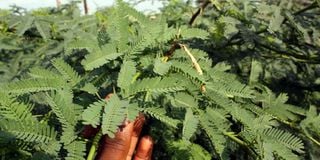Premium
Time we acted on ‘Mathenge’ weed disaster

Prosopis juliflora, commonly known as “Mathenge” in Marigat, Baringo County.
When I was the director-general of the National Environment Management Authority (Nema), in 2003-2006, I vehemently condemned the spread of Prosopis juliflora, commonly known as “Mathenge”.
That was, however, against the belief of many people that every green vegetation is a perfect contributor of the 10 per cent afforestation benchmarked by environmental authorities.
While I was the greatest proponent of Kenya’s environmental restoration, I took very serious exception of the spread of Mathenge in our arid and semi-arid lands (ASAL). At that time, it had aggressively invaded thousands of hectares of land in the northeastern region, northern counties of Baringo and Turkana and parts of Nakuru further south.
I would witness desperate pastoralists present a toothless goat to the High Court to make a case for compensation for the damage that the weed had caused to their livestock. Some goats had lost their teeth due to poisonous compounds found in Mathenge pods. The poison was wearing out and removing the goats’ teeth. They won the case.
I did an extensive study on Mathenge and was convinced that our country could not contain the fast-spreading weed, no matter the physical, chemical, mechanical or biological control methods we applied. This is one of the most obnoxious and invasive weeds recorded but has excellent uses once contained.
In Kenya, however, it has overrun us. Not even burning the weed for charcoal can eradicate it. Besides, it is exclusive: No other plant or grass can survive under its canopy. It towers over bomas, manyatas and riverine and also very dry terrains.
Trapping flamingos
With floods in areas where Mathenge thrives, it is trapping flamingoes, which starve to death. The poor birds cannot avoid flying into the thorny branches of the 30-40-metre high shrubs.
The solution to the Mathenge disaster lies in my earlier advice to manually uproot the weed for commercial use. Few countries have successfully controlled Mathenge by using energy-producing mechanisms. That should be introduced in Baringo; sadly, the equipment does not work. Alternatively, engage the able-bodied youths in an aggressive manual removal and destruction of the weed.
Further, once the water recedes, uproot and burn all the dried-up plants to avoid the regeneration of the weed. Progressively clear the banks of the lakes of the weed, and that should be extended to the drier areas. It will be expensive but worth it. The charcoal burning moratorium should be considered.
Science does not lie. Research strengthens statistics and the public is advised accordingly. Policymakers may use or ignore the information altogether — at their peril. Meanwhile, revisit the advisory given by Nema 18 years ago. The facts remain unchanged. Let us save our ecosystem and tourism.





